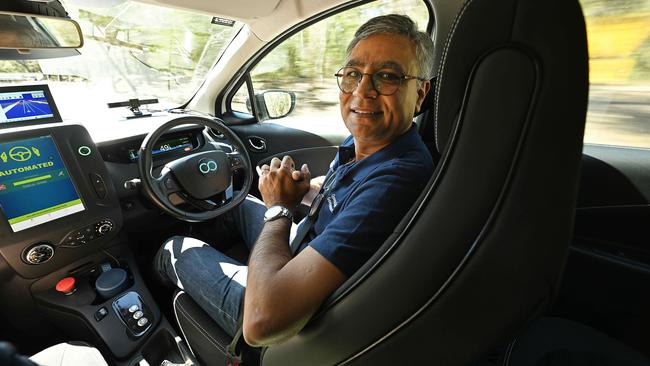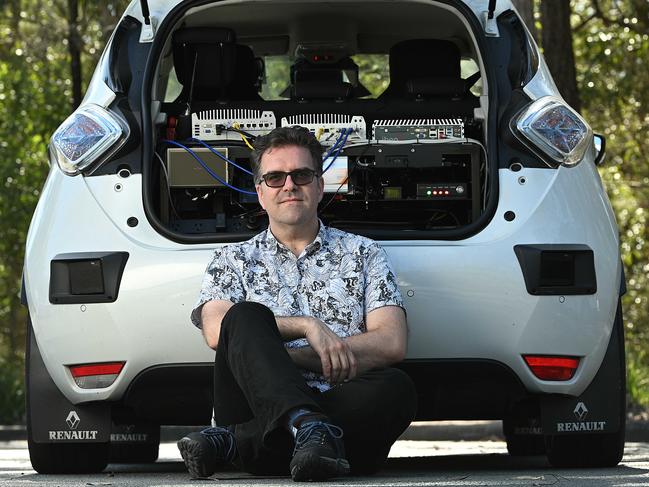Much-hyped reality of the driverless car finally edges into view
The steering wheel turns on its own accord, indicators snap on and off, the accelerator pumps as the most advanced driverless car in Australia hits 50km/hr. Let’s take it for a spin | WATCH

With the push of a button, Zoe2 is transporting us into the future. The steering wheel turns on its own accord, indicators snap on and off, the accelerator pumps as the most advanced driverless car in Australia hits 50km/hr.
Like everything in this space, it’s moving faster than you might think.
The much-hyped reality of the self-driving or autonomous vehicle is finally edging into view. This particular iteration of the technology is bolted into a standard Renault Zoe hatchback – hence the moniker – tricked out with state-of-the-art sensors and computer systems capable of performing most safe manoeuvres on the road.
If someone walks into its path, the car will stop itself. Obstacles are avoided, corners rounded. Traffic signs are detected and road rules obeyed to the letter of the law.
“In a lot of respects, Zoe is a safer driver than I could ever be,” says co-developer Amit Trivedi, citing an oft-stated benefit of putting machines in the driver’s seat.

But haven’t we heard the story before? Wasn’t Inquirer being assured five years ago that level 3 cars would not only be rolling off the production lines in volume by now, they would be mixing it on the open road with the Flintstonian holdouts?
Didn’t The Weekend Australian Magazine’s motoring writer Stephen Corby report in 2016, quoting then Audi heavyweight Dietmar Voggenreiter, that the German automaker was set to release a luxury sedan that would allow drivers to “read a book, check their emails or do their Snapchats”?
Small wonder the public seems to have relegated AVs to the never-never – a neat idea for sure, but unlikely to intrude on the day-to-day anytime soon. Trivedi, team leader of the Queensland government-backed Cooperative and Automated Vehicle Initiative (CAVI), is taking us for a spin in Zoe2 to put the contrary case.
It’s quite the ride.
To date, the modified compact has clocked up 900km on the open road, nosing through traffic in the regional centres of Bundaberg and Mt Isa in the fully autonomous mode Trivedi has engaged.
For the purposes of this demonstration, we’re on the track at the RACQ Mobility Centre at Mt Cotton, southwest of Brisbane. A dedicated high performance testing site, it’s been set up to simulate some road conditions: there is a stop sign, intersections and straights where the speed can crank up to Zoe2’s set maximum of 50km/hr. Driving lanes are laid out.

“Here we go,” says Trivedi, lifting his hands off the wheel. The car accelerates more sharply than we were led to expect. Zoe2, a level 4 prototype, is the second generation trial vehicle to be worked up by the CAVI development team from state government agency Transport and Main Roads and the Queensland University of Technology, supported by the commonwealth-funded iMOVE Australia cooperative research centre.
Contrary to popular belief, the self-driving car has not been the focus of the intensifying R&D effort involving more than a dozen sanctioned AV trials – and counting – across the country. Most deploy shuttles or people movers, along the lines of the robocabs used in General Motors’ troubled Cruise trial in San Francisco, suspended recently after a sickening accident caused a pedestrian to be dragged beneath an AV. Other Australian programs feature driverless buses, trucks and semi-trailers.
Zoe2’s mild-mannered looks belie what’s going on in and around the car. The most noticeable addition is a roof dome mounting part of its electronic eyes, an advanced lidar system – light detection and ranging – that sends out pulsed laser beams to identify other vehicles, road users and objects on the tarmac, then measures the distance to them.
Paired with radar and conventional video cameras, more than three million digital markers are scanned per second to assemble a “points cloud” providing 360-degree coverage, up to 75m out. The AI-enhanced onboard computer processes the information, along with inputs from the GPS locator and other sensors to paint a multi-layered picture of the traffic conditions which is run through its programming. This is key to understanding how the current technology works.
AVs may be powered by artificial intelligence, but they aren’t self-learning machines. In other words, the car will respond to any given scenario in strict accordance with its exacting programming, not improvise on the go.
Zoe2 will follow a route punched into its roadmapping – in much the same way you might use satnav to plot an unfamiliar journey – but won’t deviate from that course once autonomous mode is activated. The car can’t read a road sign that hasn’t been entered on the database.
“I want to demystify something about AI,” says Sebastian Glaser, a professor of intelligent transport systems at QUT who works closely with Trivedi at CAVI. “When we say the vehicles are using AI systems at the moment they are not self-learning or self-improving during the driving, they are using scenarios which have been programmed into them. There is a very, very basic reason for that: liability. No car manufacturer or equipment provider will accept liability for a system it has incomplete control of.”

This also addresses the “trolley test”, that hoary what-if involving a choice between two unavoidable and tragic outcomes. In a famed scenario, a grandmother and child are walking across the road together. The driverless car can swerve around one of them, but not both of them. Who does it hit? Glaser points out that AVs don’t work like that in the real world. The vehicle’s reaction time is up to four times faster than a person’s, and in the microseconds before the collision it should have options not open to a flesh-and-blood driver.
But let’s say it can’t avoid the crash. Well, that’s a question for the software engineers, Trivedi says. The programming would dictate what happened, and those choices are really up to the community to make. If the life of a child was to be prized over that of an elderly person, society should deem it so – perhaps through parliament or a regulatory authority – after careful debate and consideration. “The car will do anything it is told to do,” Trivedi says. “But someone has to figure out what that should be, in any given situation.”
The technology is certainly not the issue. Most new cars are already at level-2 on the five-tier automation scale owing to safety features such as lane assist, adaptive cruise control, anti-lock braking and electronic stabilising. At level-4, the car is fully-automated and able to operate on any road surface, in all conditions; level-5 does away with any pretence of driver involvement: there is no steering wheel or manually-operated controls in the cabin.
The first level-3 production models allowing for hands-off operation have now hit the market in Europe and the US, led by Mercedes-Benz’s flagship S-class and EQS models which sell for between $244,000 and $332,000 in Australia. The company’s Drive Pilot package, not available here, can be activated only on designated freeways in Germany, California, Arizona and Nevada, to a maximum speed of 60km/hr. BMW’s equally pricey 7 Series and i7 offerings for 2024 will have a similar self-driving option for an extra €6000 ($9825).
“The big tech companies and automotive makers know the business and they’ve been in this space for many years; they will develop the technology as it continues to advance,” Trivedi says.
“Our job is as an enabler. We want to be sure we are ready when they are with the required regulatory framework, the infrastructure and also the public acceptance when it comes time for these cars to be allowed on the road in Australia.”
All things being equal, that will be as soon as late 2026. Nearly a decade of preparatory work between federal and state government agencies and commercial parties including the insurance industry is due to come together then, though few will be surprised if the deadline slips.
The legal and regulatory issues are fraught with complication. For a start, a new entity is to be dropped into the liability mix: the automated vehicle itself and/or the computer software that calls the shots once the human driver cedes control. So far, the major car manufacturers have said they will be accountable in what’s purported to be the highly unlikely event of a crash.
The Insurance Council of Australia has told NSW politicians: “The question of who has control of an autonomous or driverless vehicle at any point in time, presents significant challenges for determining liability for loss and damage. This in turn has implications for ensuring access to appropriate compensation for injured road users.
“Where fault must be determined … a shift to product liability or manufacturer’s liability may need to be considered. In circumstances where drivers can override automated systems, for example to avoid an accident, determining the balance between the manufacturer’s liability and the driver’s responsibility, for the purpose of establishing fault, may be particularly challenging.”
Take the field test we conducted with Zoe2. Trivedi agreed to demonstrate the failsafe programming to protect unwary pedestrians when self-driving was engaged. He would walk into the path of the car as it came on at 50km/hr, clutching a kill switch just in case. Expert driver Sebastien Demmel was hands-off at the wheel, but ready to take over. If all went to script, Zoe2 would smoothly brake, pull up, and then follow him as he turned towards where we were videoing the scene. What could possibly go wrong?
Inevitably, it was the interface between machine and man. When the AI calculated that Trivedi would clear the lane at the pace he was walking, the car sped up instead of slowing down. An alarmed Demmel tapped the brakes, deactivating the automation to unleash a heart-stopping moment when the car veered and juddered to a halt. They got it right on the second try.
The sequence of events that precipitated the Cruise fiasco in San Francisco on October 2 was both unpredicted and horrific. The female pedestrian was struck by a conventional car while crossing an intersection and flung into the path of the driverless taxi that ran her over, stopped and then dragged her 6m before parking itself at the curb, severely injuring the woman. Evidently, the Cruise AV had adhered slavishly to a safety protocol to pull off the road were it in an accident. In the fallout, the GM subsidiary’s chief executive, Kyle Vogt, resigned and more than 400 of the test cars were taken off the road in the US.
National Transport Commission CEO Michael Hopkins says the crash is being studied closely by regulators around the world, including here: “It changes people’s risk appetite … and there is a very low tolerance in Australia for putting people at risk in these kinds of trials.” The NTC is leading the national effort to pave the way for AVs through an intergovernmental agreement between the commonwealth and the states, with the legal framework due to go before the various parliaments from next year. The expectation is a standalone agency will be created to oversee the introduction and use of AVs.
The devil, as always, is in the detail. The road rules in most jurisdictions aren’t explicit that a driver must have hands on the wheel, for example; but the driver is required to pay due care and attention. How will those responsibilities be defined in an AV? Drivers will probably be allowed to read or watch a video when automated mode is engaged, per Voggenreiter’s prediction. But, at level three, they must be able to take back control, meaning napping is out. A tough one to enforce.
Speaking of which how will police go about pulling over a driverless car? Who or what cops the fine for speeding through a temporary roadworks zone? Does the alcohol limit apply? As Hopkins wryly observes: “There’s quite a few moving parts here.”
He won’t be drawn on whether the 2026 deadline can be met, though he says the heroically wrong assumptions about the arrival of AVs on a road near you reflects an “optimism bias” that is giving way to a more clear-eyed view of the challenges. The disruption of Covid, the compounding global shortage of computer chips and the focus on electric vehicle development by the big carmakers have taken a toll. Ford and Volkswagen have pulled the plug on their self-driving efforts.
One of the biggest unknowns is us. If people won’t accept sharing the road with driverless cars, then there’s no point bringing them in – and so far, the jury seems to be out. A 2018 study of consumer sentiment in Australia on AVs by University of Sydney researchers reported that 74 per cent of Australians were concerned about the potential for over-reliance on the technology, while 85 per cent thought it would reduce the road toll and traffic congestion (71 per cent). Other surveys have found people split roughly 50-50 on the question of whether they are in favour of driverless cars – though the younger demographic, unsurprisingly, is much more supportive than over-50s.
Corby isn’t holding his breath. Australian regulators are simply too risk-averse to take the required leap to AVs. “I think the only way it would ever work is for an even more safety-mad country, like Sweden, to set aside an area of the country where humans were banned from driving and only self-driving cars are allowed, for a six-month trial,” our motoring writer says. “Then, no one would die, the autonomous cars would work perfectly and we’d move towards banning humans from doing it altogether. That might work.
“In short, in Australia, we seem to be a long, long way off allowing too much autonomy on our roads, just as we are against having sensible speed limits of 130km/hr, as they do in Europe.”
AI guru Toby Walsh, the Scientia Professor of Artificial Intelligence at the University of NSW, is more upbeat, if cautiously so. The self-driving technology is “starting to be mature enough” to put in the hands of people, he says. He thinks long-haul freight trucks will be first cab off the rank, partly because the workforce of mostly male truckies is ageing and not being renewed, and also because remote piloting would be relatively easy to set up as a failsafe from central monitoring stations, creating backstop in case the automation failed.
“I’ve always said we’re not going to actually intend to give up driving,” Walsh says. “We’re just going to wake up one day and realise we gave up driving.”






To join the conversation, please log in. Don't have an account? Register
Join the conversation, you are commenting as Logout